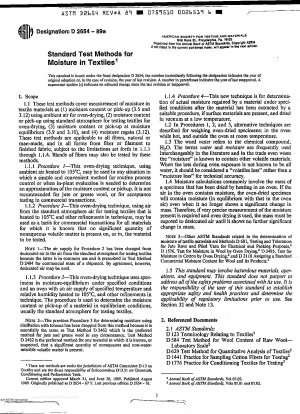ASTM D2654-89a
Standard Test Methods for Moisture in Textiles
- Standard No.
- ASTM D2654-89a
- Release Date
- 1989
- Published By
- American Society for Testing and Materials (ASTM)
- Status
- Replace By
- ASTM D2654-22
- Latest
- ASTM D2654-22
- Scope
- 1.1 These test methods cover measurement of moisture in textile materials as (1) moisture content or pick-up (3.5 and 3.12) using ambient air for oven-drying, (2) moisturecontent or pick-up using standard atmosphere for testing textiles for oven-drying, (3) moisture content or pick-up at moisture equilibrium (3.9 and 3.10), and (4) moisture regain (3.12). These test methods are applicable to all fibers, natural or man-made, and in all forms from fiber or filament to finished fabric, subject to the limitations set forth in 1.1.1 through 1.1.4. Blends of fibers may also be tested by these methods. I,1.1 Procedure 1-This oven-drying technique, using ambient air heated to 105”C,may be used in any situation in which a simple and convenient method for routine process control or when in-plant evaluation is needed to determine an approximation of the moisture content or pickup. It is not recommended for jute or grease wool, or for acceptance testing in commercialtransactions. 1.1.2 Procedure 2-This oven-drying technique, using air from the standard atmosphere air for testing textiles that is heated to 105°Cand other refinements in technique, may be used as a basis for commercial transactions for all materials for which it is known that no significant quantity of nonaqueous volatile matter is present on, or in, the material to be tested. NOTEI-The air supply for Procedure 2 has been changed from desiccatedair to the air from the standard atmosphere for testing textiles because the latter is in common use and is prescribed in Test Method D 2494 for commercial mass of a shipment. By agreement, however, desiccatedair may be used. 1.1.3 Procedure3-This oven-drying technique usesspecimens in moisture-equilibrium under specified conditions and an oven with an air supply of specified temperature and relative humidity heated to 105”C,and other refinements in technique. The procedure is used to determine the moisture content or pick-up of a material in equilibrium conditions, usually the standard atmosphere for testing textiles. NOTE2-The previous Procedure 3 for determining moisture using distillation with toluene has been dropped from this method becauseit is essentially the same as Test Method D 2462 which is the preferred method for jute and grease wool in any circumstance. Test Method D 2462 is the preferred method for any material in which it is known, or suspected, that a significant quantity of nonaqueous and non-watermiscible volatile matter is present. ’Thcsc test methods are under the jurisdiction of ASTM Committee D-13on Textilesand are the direct responsibility of Subcommittee D 1 3 . 5 1on Chemicals, Conditioning and Performance Tests. Current edition approved March 31, and June 30, 1989. Published August 1989. Originally published as D 2654 -67 T. Last previous edition D 2654 -96. 1.1.4 Procedure 4-This new technique is for determination of actual moisture regained by a material under specified conditions after the material has been extracted by a suitableprocedure, if surface materials are present, and dried in vacuum at a low temperature. 1.2 In Procedures 1, 2, and 3, alternative techniques are described for weighing oven-dried specimens: in the oven while hot, and outside the oven at room temperature. 1.3 The word water refers to the chemical compound, H , O . The terms water and moisture are frequently used interchangeably in the literature and in the trade even wnen the “moisture” is known to contain other volatile materials, When the loss during oven exposureis not known to be all water, it should be considered a “volatiles loss” rather than a ‘‘moisture loss” for technical accuracy. 1.4 Moisture calculations commonly involve the mass of a specimen that has been dried by heating in an oven. If the air in the oven contains moisture, the oven-dried specimen wili contain moisture (in equilibrium with that in the oven air) even when it no longer shows a significant change in mass. Therefore, if very precise measurementof the moisture present is required and oven drying isused, the mass must be exposed to desiccated air until it shows no further significant change in mass. NOTE3-Other ASTM Standards related to the determination of moistureof textile matenais areMethods D 681,Testingand Tolerances for Jute Rove and Plied Y a r n for E l e c t r i c a l and Packing Purposes,* B 1546,T e s t for Moisture in Wool by Oven Drying? D 2495, Test for Moisture in Cotton by Oven Drying; and D 2118Assigninga Standard Commercial Moisture Content for Wool and its Products.2 1.5 Thisstandard may involve hazardous materials, operations, and equipment. This standard does not purport to address all o fthe safetyproblems associated with its use.It is the responsibility o f the &er o f this standard to establish appropriate safety and health practices and determine the applicability of regulatory limitations prior to use. See Section 32 and Note 13.
ASTM D2654-89a history
- 2022 ASTM D2654-22 Standard Test Methods for Moisture in Textiles
- 1989 ASTM D2654-89a Standard Test Methods for Moisture in Textiles
- 1967 ASTM D2654-67 Tentative Methods of Test for Amount Of Moisture In Textile Materials
